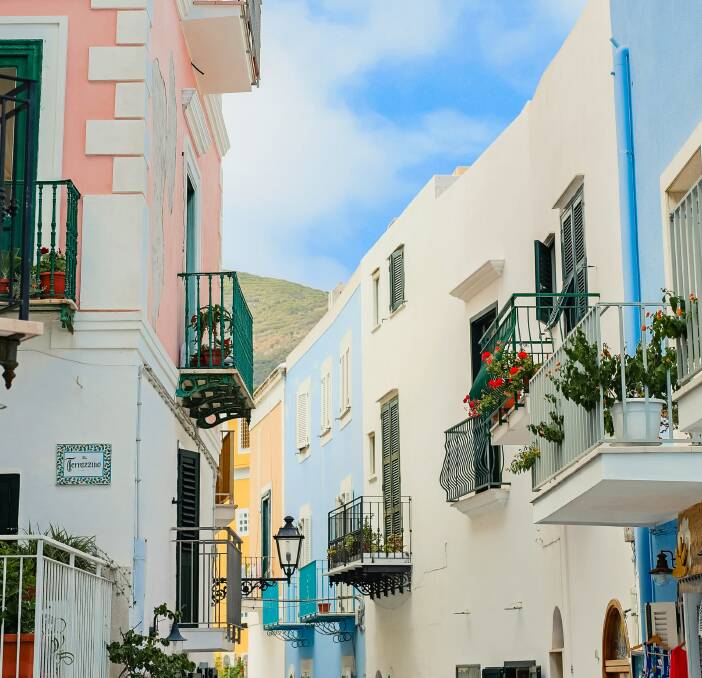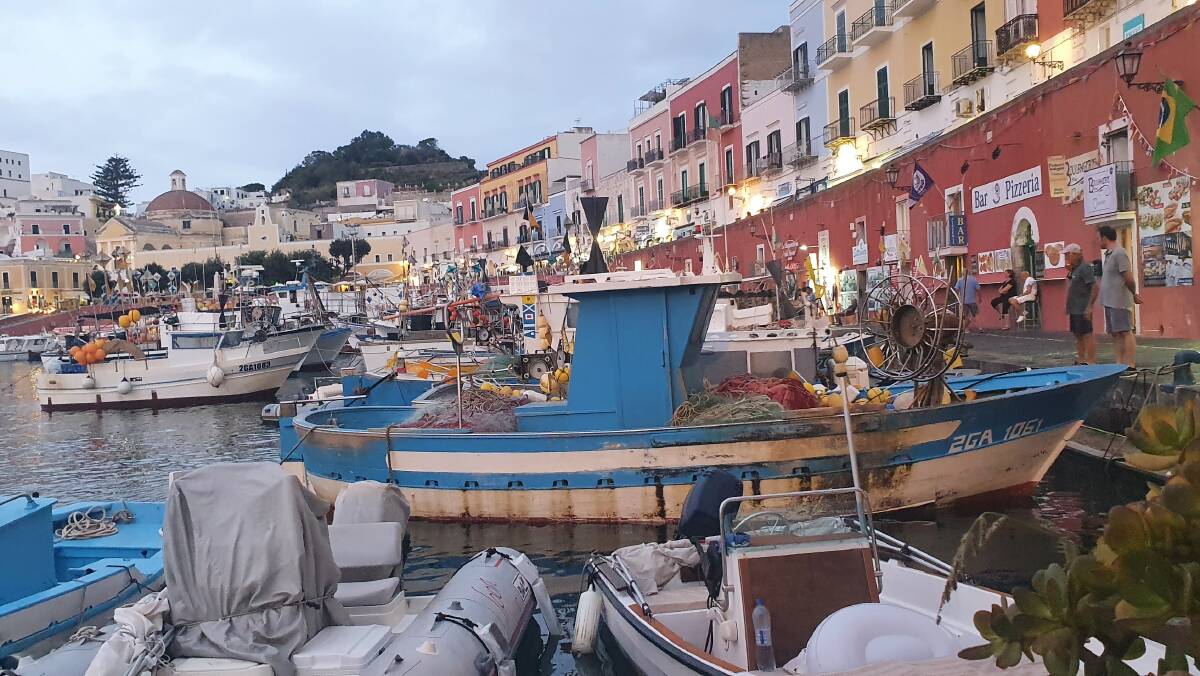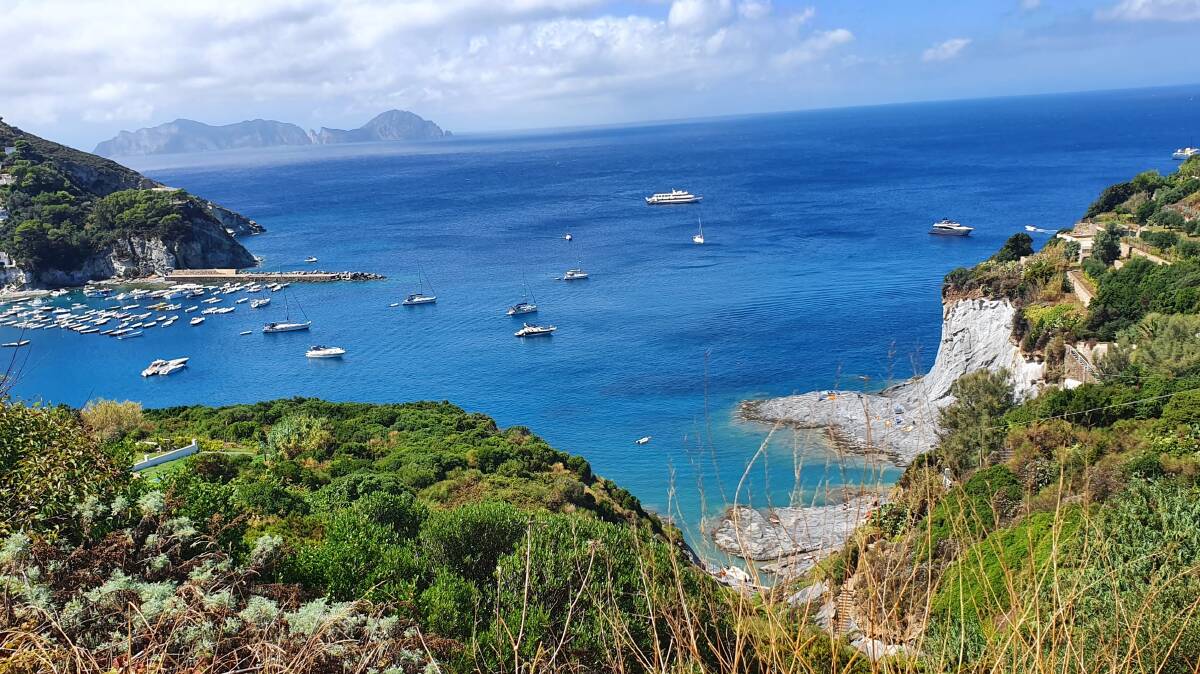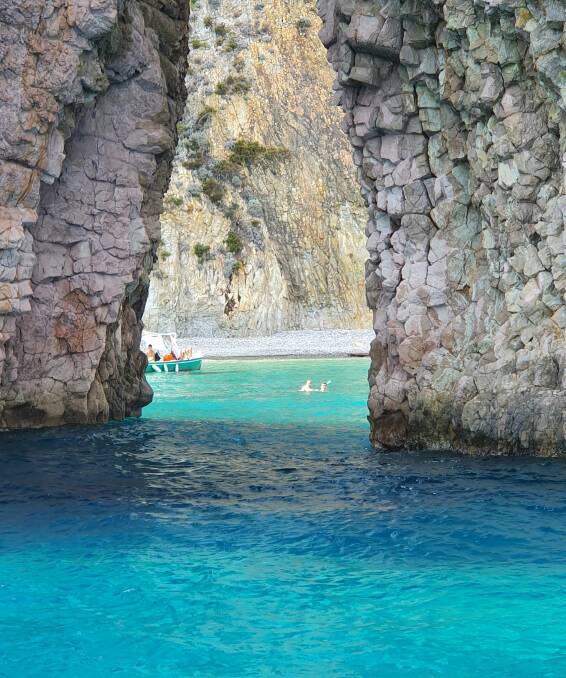It's early morning on the isle of Ponza. The sea looks like an artist has dipped a brush with the remnants of turquoise paint into a glass of water. From our terrace we watch a bagnino (lifeguard), setting out sun lounges and unfurling bright yellow umbrellas on water-smoothed black rocks surrounding a natural pool. From somewhere between the cliffs and sea, where pink, lavender and primrose-hued houses hide among unruly greenery, a rooster crows. In Cala Feola, the next cove along, fishermen unfasten their boats and putter across the bay and out to sea.
Create a free account to read this article
$0/
(min cost $0)
or signup to continue reading
The technicolour Ponza is gently shaking itself awake - later, the day will build to a crescendo of action as the island's visitors fill their beach bags, don their flip flops and shepherd their multi-generational families down the zigzagging cliff paths and steep rock stairs to settle into the serious business of swimming and tanning.

Part of the Pontine archipelago off Rome, tiny Ponza could be, but thankfully isn't, another Capri. It has all the necessary accoutrements - beach clubs, a harbour where billionaires can moor their yachts, and sprawling villas owned by famous designers and artists. But Ponza is low-key and affordable. The price of the view from our clifftop studio apartment in the village of La Forna is a case in point - utterly beyond our budget in Capri. Or Portofino or Amalfi, for that matter. "The views, the thousand inlets, the sunsets, its coasts, the pristine sea and nature, with sometimes wild elements. It is for its simplicity that Ponza is so loved," says Gino Pesce, owner of the Michelin-starred Acqua Pazza, who has lived his entire life on the island.
There's so much beauty, we're happy to just sit and absorb it.
Despite Ponza's untamed beauty, foreign tourists are few - mainly Italians, especially Romans and Neapolitans come, often returning annually.
Marco, a young Roman who now lives in Los Angeles, has been coming every summer since he was six years old.
"You are adventurous to come here," he tells us, speaking the only English we hear in five days. "It's not so easy."

It's not so difficult either. From Rome, we have taken a train west to Formia on the coast, then an aliscafo (fast boat) another hour-and-half to the island's half-moon port, which looks like a more colourful version of a Greek island. But it may be this, those extra hours carved out of tourists' precious holiday time that has preserved the "Italianissimo" ambience of Ponza.
Formed by volcanic eruptions, cataclysmic seismic occurrences and man, the island's coastline is pocked by caves. Like Capri, Ponza was "discovered" by the ancient Romans and they excavated caves such as The Pilate Grottoes to use for the breeding of fish, in particular, the moray eels, a fish considered sacred. Other caves were thought to be used for religious ceremonies, with niches carved into the rock, housing statues of pagan divinities.
Unlike Capri, however, you can actually swim in some of Ponza's semi-submerged "blue grottoes".
In the harbour we buy a ticket from the local "boatmen's cooperative" - the Co-op Barcaioli Ponzesi, and join families for a tour around the island. The limpid surface of the Tyrrhenian Sea is broken only by the tiny islets and the uninhabited islands of Palmarola and Zannone, and faraglione, or towering rocks eroded by time and water.

It's no matter we don't understand the majority of the commentary of the skipper, who, by the raucous laughter and good-natured retorts would seem to be something of a raconteur - there's so much beauty, we're happy to just sit and absorb it. He drops anchor in small coves, the sheer cliffs making them inaccessible from shore and we jump off, into water so crystalline, we're fooled into thinking we can dive to touch the bottom. We swim through caves where schools of small silvery fish part and dart off and shafts of light pierce the water turning our bodies a glowing aquamarine.
Lunch is included; a simple pasta scarpariello, tomato, parmesan and a pinch of chilli, eaten from our laps, with white wine poured from a plastic gallon bottle.
All the food on Ponza is very good - unsurprisingly strongly seafood-focused. A speciality is the locally caught ricciola - a delicate, sweet white-fleshed fish, as well as spada (swordfish), dentice (red mullet), cuttlefish and anchovies.

At Gino Pesce's Acqua Pazza, awarded a Michelin star in 2006, there is a romantic leafy terrace overlooking the harbour and a contemporary menu that rarely strays from its "zero-kilometre" ethos. It may be Michelin-starred, but in relaxed Italian style, the table next to us has their golden retriever tucked beneath their feet, while another couple sit at the table with their extremely well-behaved toddler.
We eat ricciola as a carpaccio with caper dust, and grilled cuttlefish, thinly sliced and sweet, with a salad of mint and poppy seeds; red snapper tortelli with a fresh tomato foam and miso-glazed swordfish with carrot puree.
It is, of course, possible to eat more frugally on Ponza. Its gorgeous harbour is lined with little places selling paper cones of deep-fried seafood, roasted meats, pizza or panini. Apart from eating and swimming there are tiny wineries to visit, an underground Roman aqueduct to explore and excursions to the other islands.
"You know, you are lucky," an Australian tour guide who takes groups to Italy told me before we left Australia. "Ponza is virtually unknown outside of Italy but I have a feeling it's going to explode in popularity soon."
Selfishly, I hope not, but it may be that Ponza will one day emulate Capri. For now, though, Ponza is the perfect place to experience the real Italy - at least the real Italy on holiday.
TRIP NOTES
Getting there: The best time to visit is May, June and September. After September, boat connections can be limited.
Fast boats take about an hour and 45 minutes from the ports of Formia and Anzio, south of Rome to Ponza. You can book tickets via Laziomar
Where to stay: There are some small hotels around the port like the simple Hotel Mari but consider staying like locals do, in an apartment. La Forna is at the quieter end of the island and has breathtaking views. Agenzia Maridea manage apartments all over the island. There are also some options on Airbnb.
Getting around: A minibus traverses the island's one major road frequently until late at night, taking about 20 minutes from Punta Incenso at one end of the island, via La Forna to the Port. The cost is 2 Euro each way, or buy a 24 hour ticket (at the bus stop at the port or "tabaccherie" around the island) for 5 euro which allows you to get on and off. There are usually taxis in the port as well.
Boats frequently leave the port for beaches around the island and for day trips. You can also hire your own boat, with or without a skipper (no experience required!)
Where to eat and drink: Acqua Pazza - for upmarket contemporary Italian, Il Timon or Oresteria are both popular, and feature seafood, Bar Tripoli and Magi Circe are great for aperitivi - all at the port. Tramonto in La Forna has spectacular views.
*If you have mobility issues, Ponza may be difficult - it's very steep in parts and there are a lot of stairs.




